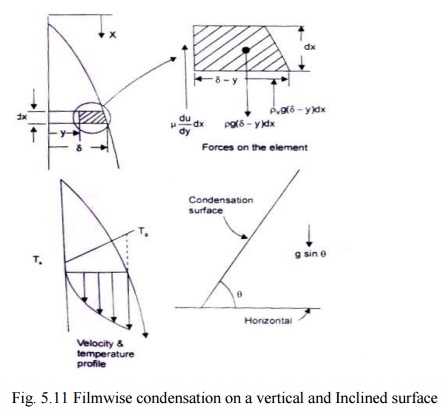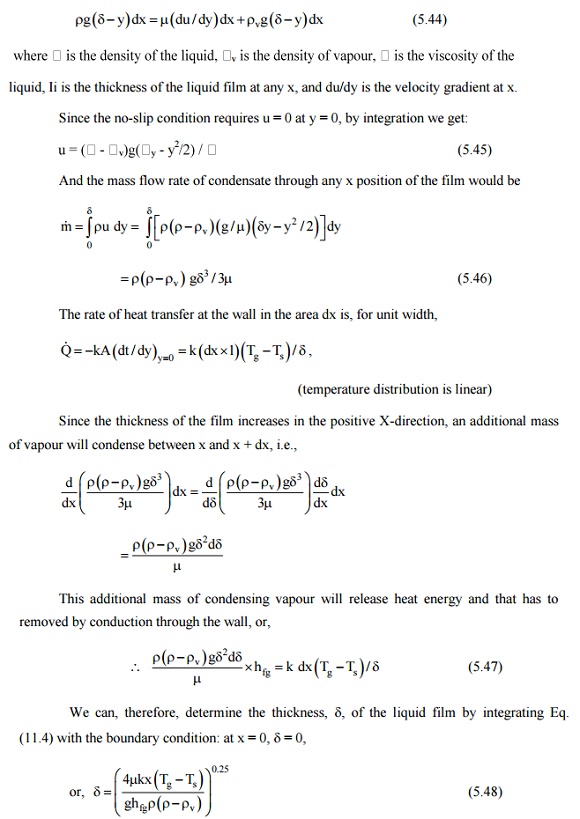Chapter: Mechanical : Heat and Mass Transfer : Phase Change Heat Transfer and Heat Exchangers
Condensation-Filmwise and Dropwise
Condensation-Filmwise and Dropwise
Condensation
is the process of transition from a vapour to the liquid or solid state. The
process is accompanied by liberation of heat energy due to the change 10 phase.
When a vapour comes 10 contact with a surface maintained at a temperature lower
than the saturation temperature of the vapour corresponding to the pressure at
which it exists, the vapour condenses on the surface and the heat energy thus
released has to be removed. The efficiency of the condensing unit is determined
by the mode of condensation that takes place:
Filmwise
- the condensing vapour forms a continuous film covering the entire surface,
Dropwise - the vapour
condenses into small liquid droplets of various sizes. The dropwise
condensation has a much higher rate of heat transfer than filmwise condensation
because the condensate in dropwise condensation gets removed at a faster rate
leading to better heat transfer between the vapour and the bare surface. .
It is therefore
desirable to maintain a condition of dropwise condensation 1D commercial
application. Dropwise condensation can only occur either on highly polished
surfaces or on surfaces contaminated with certain chemicals. Filmwise
condensation is expected to occur in most instances because the formation of
dropwise condensation IS greatly influenced by the presence of non-condensable
gases, the nature and composition of surfaces and the velocity of vapour past
the surface.
Filmwise Condensation Mechanism on a
Vertical Plane Surface--
Assumption
Let us consider a plane
vertical surface at a constant temperature, Ts on which a pure
vapour at saturation temperature, Tg (Tg > Ts)
is condensing. The coordinates are: X-axis along the plane surface wit~ its
origin at the top edge and Y-axis is normal to the plane surface as shown in Fig.
11.1. The condensing liquid would wet the solid surface, spread out and form a
continuous film over the entire condensing surface. It is further assumed that
(i) the continuous film
of liquid will flow downward (positive X-axis) under the action of gravity and
its thickness would increase as more and more vapour condenses at the liquid -
vapour interface,

Fig.
5.11 Filmwise condensation on a vertical and Inclined surface
(ii)
the continuous film so formed would
offer a thermal resistance between the vapour and the surface and would reduce
the heat transfer rates,
(iii) the
flow in the film would be laminar,
(iv)there
would be no shear stress exerted at the liquid vapour interface,
(v) the
temperature profile would be linear, and
(vi)
the weight of the liquid film would be
balanced by the viscous shear in the liquid film and the buoyant force due to
the displaced vapour.
An Expression for the Liquid Film
Thickness and the Heat Transfer Coefficient
Laminar
Filmwise Condensation on a Vertical Plate
We
choose a small element, as shown in Fig. 11.1 and by making a force balance, we
Write
rg dy-dx
=dum/dy
dx g + ry dxd -



zero, (a horizontal surface) we would get an absurd
result. But these equations are valid for condensation on the outside surface
of vertical tubes as long as the curvature of the tube surface is not too
great.
Related Topics